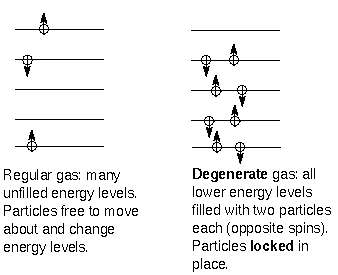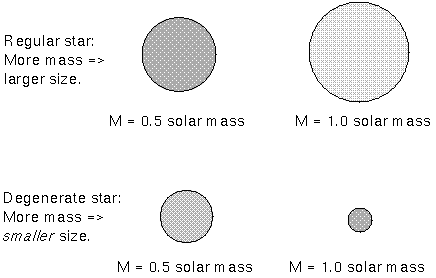This material (including images) is copyrighted!.
See my copyright notice for fair use
practices.
All that is left of the star after the outer layers are ejected to space is
the core remnant. The core's gas is super-compressed by gravity to form a
strange type of gas made of ``degenerate matter''.
It is important to remember that what happens to the core depends on
the mass of the core, rather than the original mass of the main sequence
star from which it came, because the only thing left for gravity to really
compress is the core.
When gas become super-compressed, particles bump right up against each other
to produce a kind of gas, called a degenerate gas, that behaves more
like a solid. Normal gas exerts
higher pressure when it is heated and expands, but the pressure in a degenerate
gas does not depend on the temperature. The laws of quantum mechanics must be
used for gases of ultra-high densities.
The first rule is that only certain energies are permitted in a closely
confined space. The particles are arranged in energy levels like rungs of an
energy ladder. In ordinary gas, most of the energy levels are unfilled and the
particles are free to move about. But in a degenerate gas, all of the lower
energy levels are filled. The second rule is that only two particles can
share the same energy level in a given volume at one time. For white dwarfs the
degenerate particles are the electrons. For neutron stars the degenerate
particles are neutrons. The third rule is that how close particles can be
spaced depends inversely on their masses. Electrons are spaced further
apart in a degenerate electron gas than the neutrons in a degenerate neutron
gas because electrons are much less massive than neutrons.
Let's see how these rules affect the core remnant.
- Degenerate gases strongly resist compression.
The degenerate particles
(electrons or neutrons) are locked into place because all of
the lower energy shells are filled up. The only way they can move is to
absorb enough energy to get to the upper energy shells. This is hard to
do! Compressing a degenerate gas requires a change in the motions of the
degenerate particle. But that requires A LOT of energy. Degenerate particles
have no ``elbow room'' and their jostling against each other strongly resists
compression. The degenerate gas is like hardened steel!

- The pressure in a degenerate gas depends only on the speed
of the degenerate particles NOT the temperature of the gas. But to change
the speed of degenerate particles requires A LOT of energy because they are
locked into place against each other.
Adding heat only causes the non-degenerate particles to move faster, but the
degenerate ones supplying the pressure are unaffected.
- Increasing the mass of the stellar core increases the
compression of
the core. The degenerate particles are forced closer together, but not much
closer together because there is no room left. A more massive stellar core
remnant will be smaller than a lighter core remnant. This is the
opposite behavior of regular materials: usually adding mass to something makes
it bigger!

 Go back to previous section --
Go back to previous section --
 Go to next section
Go to next section
last updated: 25 May 2001
Is this page a copy of Strobel's
Astronomy Notes?
Author of original content:
Nick Strobel



![]() Go back to previous section --
Go back to previous section --
![]() Go to next section
Go to next section